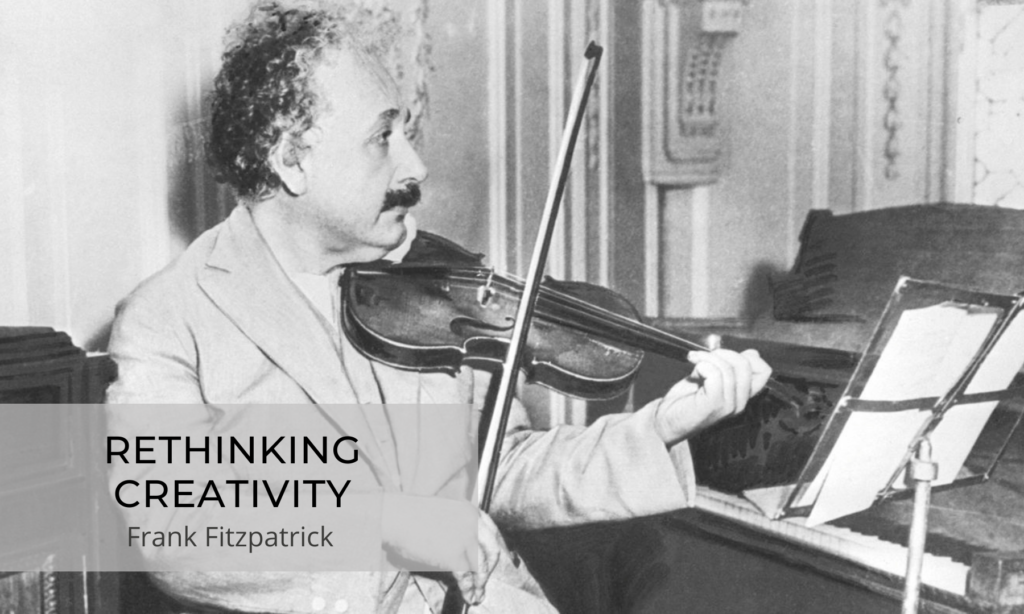Home Frank’s Blog Rethinking Creativity
Rethinking Creativity
Frank Fitzpatrick 07/06/2021

|
No time to read? Pick your language & press PLAY
Getting your Trinity Audio player ready...
|
Rethinking Creativity
One cloudy UK Sunday, I took the train across the scenic route from London to Canterbury. It was on those ancient cathedral grounds that I would spend the next few days collaborating with an international group of experts from academia and industry. We came together as recipients of the Arts and Humanities Resource Council grant to explore the potential of video games to advance creativity, learning, and musical expression. I was asked to give the opening presentation, providing a framework and definition for creativity.
Creativity is a big topic for me. I have built my entire career from the wellspring of my creative output. More importantly, like late creativity guru Ken Robinson, I believe creativity is one of the most important qualities we can cultivate within our children and leaders. You might notice, I didn’t say “give them.” Creative ability exists within all humans. Further, as beautifully expressed by psychologists Phil Shultz and Barry Michels in The Tools: Our creative potential is what makes us uniquely human. In this perspective, the unavoidable challenges of life from which we are never fully exonerated are simply gifts to help us exercise our creativity and fulfill our quest for self-actualization. In other words, opportunities to actualize our innate creative potential.
Helping children identify and actualize their creative potential is one of the best ways to prepare them for an uncertain future. Creativity helps us be more resourceful, adapt more easily, and live more satisfying and inspired lives. Beyond the opportunity to enter a commonly-called “creative” career, a child’s creative potential is key to helping them thrive in science-based fields like physics, technology, and medicine.
In business – especially in the context of innovation and market adaptation, creativity has been ranked by leading futurists and Fortune 500 CEOs as one of the most important attributes of tomorrow’s leaders. Whether in business, education, health, the arts, or politics, we will need more purpose-driven and creative visionaries at the helm to help society navigate the unchartered and turbulent waters that lie ahead.
Defining Creativity
With all the talk about creativity, one might expect to find a widely accepted definition. I know I was hoping to do so when preparing for my presentation in Canterbury. This, however, is not the case. There is a blurred line, for example, in the business and VC world in the delineation between creativity and innovation. Some differentiate by claiming that innovation has more to do with repurposing or reorganizing existing resources in a new and creative fashion. Although proponents of that theory might place Steve Jobs at the top of the innovator list, others would argue that Jobs’s ability to integrate existing technological breakthroughs into beautiful, original, and user-friendly designs is a mark of creative genius. Both views are correct to some extent.
In my research, I challenged myself to question why it was so difficult to come up with a fixed definition of creativity in the first place. Is it an inner source of potential? Is it a law of physics and science? I realized one answer might lie within the nature of creativity itself. Like water flowing in a stream, creativity is far more of a continuum than a fixed or definable state.
In an attempt to share more concrete with my colleagues, I decided to start at the source of the spring – at the beginning of that continuum. I would start by defining the act of creation.
Cre•a•tion (v) act of bringing something into existence.

Pregnant woman with violin
Creation is what I sometimes refer to as pure creativity – the bringing into existence that which didn’t exist before. In the creative process of a visual artist or writer, this might be the spark of a new idea, leading to the first mark on a white canvas or blank page. For a composer, it might be a sudden arrival of a melodic motif inside the mind, leading to the first note on the staff or the keys of a piano – that initial sonic seed that can take on life and eventually blossom into an entire film score. For a parent, the undeniable masterpiece represented in a newborn child starts with the union of the egg and the sperm. Or would it be the spark in the eyes of the lovers that lead to that union?
It can also be challenging to define creativity, like energy, as a physically tangible state, as has been a key objective of researchers in the science of Flow. Creation, being an action with an outcome, can typically be described at a more tangible level. In this simplified view, we can define creation as the transformation of something from an invisible, latent, or intangible state (like an idea) into a new manifested form in the world that others can witness or experience (an invention, a musical composition, a speech, a painting, a child, etc).
Challenges to The Creation Theory
Unfortunately, I had still not come up with a clearer definition of creativity by this distinction. I had simply opened the floor for more questions. The same divisions of thought that arise in business debates between creativity and innovation could easily poke holes in my definitions of creation.
Let’s look at music again as a framework. Based on what I previously presented, one might conclude that certain ways of making and performing music (i.e. producing a remix, performing as a DJ, re-arranging an existing composition, or playing a written or learned melody by rote) are forms of creative expression, but not true acts of creation. Can we honestly say this is true? Maybe not. At least not without any more justification than one could deny the highly innovative Steve Jobs as anything less than a master of creativity.
Makers and Music
While it is as much a Maker’s story as a musical one, I fell in love with the idea and actualization of the Landfill Harmonic project. It is the ultimate and true tale in which creativity unites passion and resourcefulness. A few years ago, a young composer in an extremely impoverished community in Paraguay wanted to create a youth orchestra. Unfortunately, they had no instruments. Their meager homes were surrounded by garbage dumps, where many of them worked and others went treasure hunting.
The composer found a craftsman and luthier and convinced them to help make the instruments from fragments and parts they could collect from the garbage dumps. What came of this – from a crazy vision and a pile of meaningless trash, was the perfect metaphor for applying our creative potential to further develop the creative potential of others. The composer, the craftsmen, and the kids began their creative journey to having a fully functioning youth orchestra, each player with a crude patchwork instrument.

Some might have called this highly innovative. And though I am personally more in awe of their ingenuity, passion, and resourcefulness than by their ability to create music, I would have a hard time not defining this as a creative act, and even a highly purposeful act of creation.
Video Games As a Means to Enhance Creativity and Musical Expression
Back to the meeting of the minds in Canterbury, and my presentation…
In the end, as I strove to set a foundation for our AHRC sessions by defining creativity, I may have unveiled more questions than provided clear answers. In the process, I opened up one of the core questions we were there to explore:
Is video game-playing a form of creativity?
I guess it depends on what you are creating. Some games allow for higher degrees of creative expression within the game, while a select few, like Disney’s Fantasia game (which I premiered at another forum in California on Creativity, Music and Interactive Media in Education), allowed the player to create something they can keep and share when the game is over. In the latter case, you are playing for the sake of creating – for the joy of demonstrating your creative potential to yourself and your friends. While other games, like most shooter games and games meant to mindlessly pass time, it might be fair to say we are not playing to create anything (other than a few neuro-chemical rushes), and thereby not furthering the actualization of our creative potential.

What good games and challenging game playing can do, however, is catalyze creativity by awakening the imagination of the player, thus opening their minds to a new range of possibilities for creative problem-solving. Games can stimulate the player’s psychological resourcefulness and desire to overcome obstacles to get to the next and more challenging level. The addition of physical controllers and active movement allows us to engage our bodies and kinesthetic processes that can further stimulate creativity.
The music within a game can also stimulate imagination and creative thinking. And games that require the player’s musical performance or dance can provide a gateway into those creative and health-boosting activities, even where there may not have been one previously (at least in the mind of the player). These experiences can even help boost the confidence and inspiration to pursue professions that embrace those skills.
Music and Video Games: Creative Foreplay
The purest creative experience for the avid gamer might actually come when they feel drawn to put the video game aside and make their own game or creative work – one that emerged from a spark of their imagination triggered by the experience of playing. There are massive online communities of gamers and game fans where these creative individuals can freely share their ideas through videos, graphics, or musical selections.
There are also many established professionals using music to help them access their creative potential in fields like science, athletics, filmmaking, or entrepreneurship. Albert Einstein is one well-documented genius who would take frequent breaks to perform music to amplify his creativity as he sought to make breakthroughs in science and physics. Polymath Leonardo Di Vinci would hire musicians to perform for him while he worked in his studio.
Better Questions and the Value of Play
The best answers are often just new and better questions on the continuum of seeking to understand creativity. While some distinct findings came out of the collaboration between the multi-disciplinary group with whom I spent those few days, there is still much to be learned about creativity and, more specifically, about how the long term use of video games will impact the actualization of our creative potential as a society.
I don’t personally think video games will redefine creativity. Nor do I believe they are the most direct path to unveil and unleash an individual’s innate and invaluable creative potential. I do believe, however, that video games can offer access and a whole new range of opportunities for people to enjoy the experience of creative and musical expression. This could be especially relevant for those who feel intimidated or disenfranchised by more traditional pathways. Studies have shown that a large percentage of players of music-based games, for example, later go on to learn to play a traditional musical instrument.
One of my favorite quotes about creativity, often credited to Albert Einstein is:
“Creativity is intelligence having fun.”
Music and games (whether sports, a chess match, or a multiplayer video game) do have one other thing in common: we PLAY them. Simply by employing this language (“play”) and the mental framing that comes with it, we open up to new levels of creative freedom in our minds and gain access to greater joy and fulfillment in our often challenging lives.
We don’t have to live in a slum in Paraguay to experience those challenges. Nor do we have to build our instruments from scraps found in a trash heap to express our creativity. Anyone can switch their mindset to the Play mode and, by doing so, make the journey through the steep and winding paths of life a whole lot more fun.
——-
To learn more about Music and Creativity, check out the book Amplified: Unleash Your Potential Through the Power of Music at AmplifiedBook.com.
To learn more about our forum on Music, Creativity, and Interactive Technology, check out the summary and collection of video excerpts for Education: Disrupted HERE.
You can also view a short video clip on Music and Creativity from one of my TEDx talks HERE
I’m here to help YOU create a better world, inside and out.
Contact Me© 2025 Frank Fitzpatrick Website by AllHereIndia












